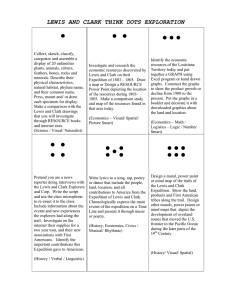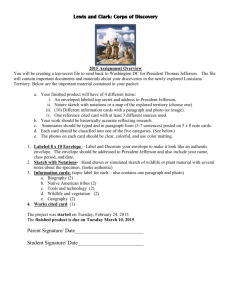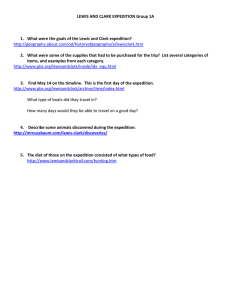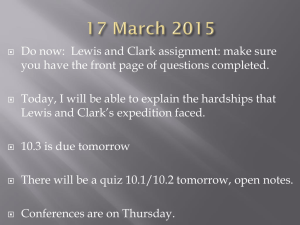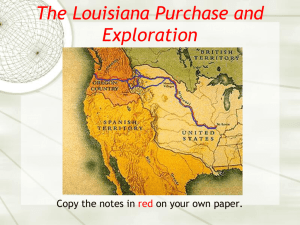Lewis and Clark Expedition
advertisement
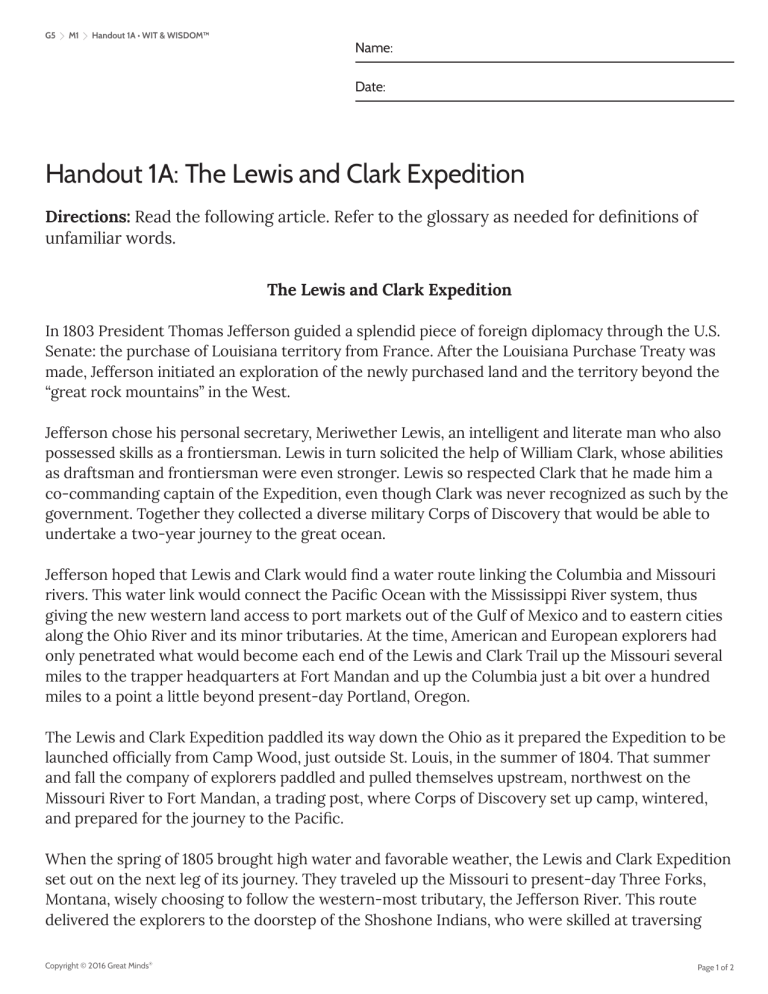
G5 M1 Handout 1A • WIT & WISDOM™ Name: Date: Handout 1A: The Lewis and Clark Expedition Directions: Read the following article. Refer to the glossary as needed for definitions of unfamiliar words. The Lewis and Clark Expedition In 1803 President Thomas Jefferson guided a splendid piece of foreign diplomacy through the U.S. Senate: the purchase of Louisiana territory from France. After the Louisiana Purchase Treaty was made, Jefferson initiated an exploration of the newly purchased land and the territory beyond the “great rock mountains” in the West. Jefferson chose his personal secretary, Meriwether Lewis, an intelligent and literate man who also possessed skills as a frontiersman. Lewis in turn solicited the help of William Clark, whose abilities as draftsman and frontiersman were even stronger. Lewis so respected Clark that he made him a co-commanding captain of the Expedition, even though Clark was never recognized as such by the government. Together they collected a diverse military Corps of Discovery that would be able to undertake a two-year journey to the great ocean. Jefferson hoped that Lewis and Clark would find a water route linking the Columbia and Missouri rivers. This water link would connect the Pacific Ocean with the Mississippi River system, thus giving the new western land access to port markets out of the Gulf of Mexico and to eastern cities along the Ohio River and its minor tributaries. At the time, American and European explorers had only penetrated what would become each end of the Lewis and Clark Trail up the Missouri several miles to the trapper headquarters at Fort Mandan and up the Columbia just a bit over a hundred miles to a point a little beyond present-day Portland, Oregon. The Lewis and Clark Expedition paddled its way down the Ohio as it prepared the Expedition to be launched officially from Camp Wood, just outside St. Louis, in the summer of 1804. That summer and fall the company of explorers paddled and pulled themselves upstream, northwest on the Missouri River to Fort Mandan, a trading post, where Corps of Discovery set up camp, wintered, and prepared for the journey to the Pacific. When the spring of 1805 brought high water and favorable weather, the Lewis and Clark Expedition set out on the next leg of its journey. They traveled up the Missouri to present-day Three Forks, Montana, wisely choosing to follow the western-most tributary, the Jefferson River. This route delivered the explorers to the doorstep of the Shoshone Indians, who were skilled at traversing Copyright © 2016 Great Minds® Page 1 of 2 G5 M1 Handout 1A • WIT & WISDOM™ Name: Date: the great rock mountains with horses. Once over the Bitterroot Mountains, the Corps of Discovery shaped canoe-like vessels that transported them swiftly downriver to the mouth of the Columbia, where they wintered (1805-1806) at Fort Clatsop, on the present-day Oregon side of the river. With journals in hand, Lewis, Clark, and the other members of the Expedition returned to St. Louis by September 1806 to report their findings to Jefferson. Along the way, they continued to trade what few goods they still had with the Indians and set up diplomatic relations with the Indians. Additionally, they recorded their contact with Indians and described (and at times drew) the shape of the landscape and the creatures of this western world, new to the white man. In doing so, they fulfilled many of Jefferson’s wishes for the Expedition. Along the way, William Clark drew a series of maps that were remarkably detailed, noting and naming rivers and creeks, significant points in the landscape, the shape of river shore, and spots where the Corps spent each night or camped or portaged for longer periods of time. Later explorers used these maps to further probe the western portion of the continent. The Expedition of the Corps of Discovery shaped a crude route to the waters of the Pacific and marked an initial pathway for the new nation to spread westward from ocean to ocean, fulfilling what would become to many Americans an obvious destiny. Over the next two centuries the new Americans and many immigrants would wash across the central and western portions of what would eventually become the contiguous 48 United States. This wave of development would significantly transform virgin forests and grasslands into a landscape of cities, farms, and harvested forests, displacing fauna such as the buffalo and squeezing the Indians who survived onto reservations. This article was written by Douglas Perry, a teacher at Gig Harbor High School, in Gig Harbor, WA. Courtesy of the U.S. National Archives & Records Administration. diplomacy: the practice of conducting negotiations and agreements between nations or governments. initiated: began frontiersman: a man who lives on or near a frontier, or the limit of settled land draftsman: a man who has exceptional skill in sketching or drawing corps: a group of people joined in some common activity route: a course of travel from one place to another tributaries: rivers or streams that flow into a larger river or stream, or into a lake penetrated: gone into or through diplomatic relations: agreements between two or more countries or groups on issues such as peace-making and trade. probe: explore or examine more deeply crude: done in a rough way destiny: something which has been predetermined, or decided beforehand displacing: forcing out of a homeland or established place reservations: areas of land set aside by the U.S. Government for the use of Native Americans Copyright © 2016 Great Minds® Page 2 of 2
